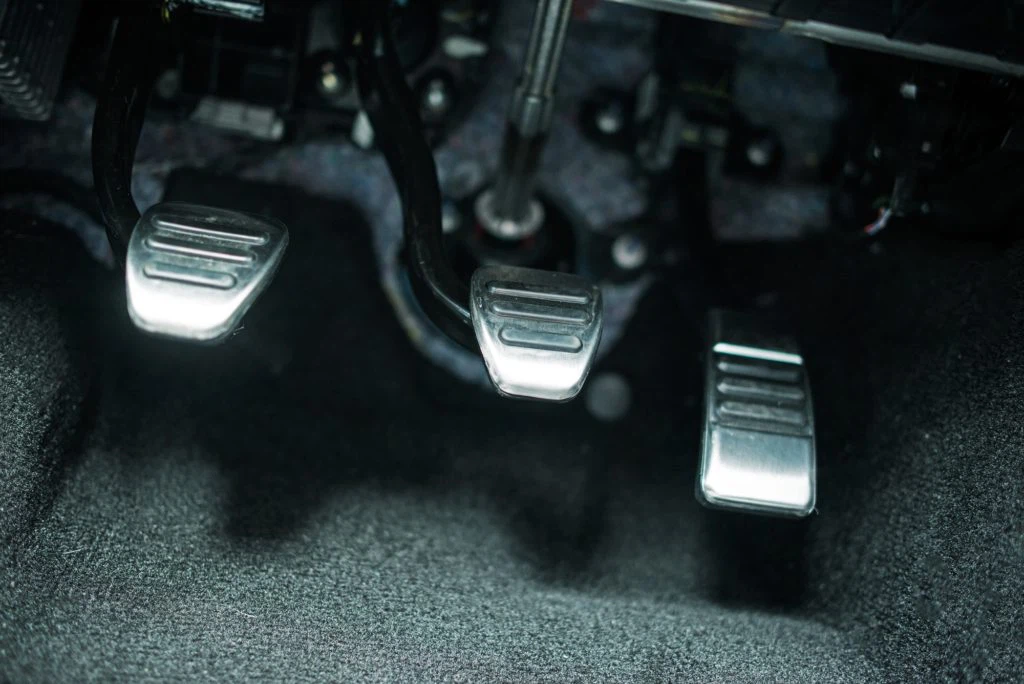The Process of Double Clutching Explained
It takes one clutch movement to pull it out of gear and another clutch movement to pull it back into the next gear.
That’s why it’s called double clutching.
Push the clutch pedal down once to slide it into gear
Push the clutch pedal down to slide it out and
Then double clutch again to slide it back into the next gear.

Getting the Feel of Double Clutching
Double clutching is not like driving a standard car.
When you’re driving, both feet are working in harmony with the other.
Listen to the revs. Especially if you’re on a hill, you don’t want your revs to drop so low that when you ease out the clutch that you’re lugging the motor.
When you ease out on the clutch, make sure that your revs are high enough that you’re won’t stall the truck. It should be a harmonious move between your two feet and your gear shift. Just feather it in and out of gear. Don’t force the shift.
If you sense resistance, you’re not doing it correctly. The shifter should slide in and out like a knife through hot butter. The move should be nice and smooth when it’s done correctly.
Working The Clutch Brake
The purpose of the clutch is to slow down the transmission just enough so that the driver can slide it into gear.
When the clutch is pushed completely down to the floor, the clutch brake is engaged.
The only time it is necessary to have the clutch brake engaged is for moving the vehicle from a dead stop.
When you’re double clutching when moving down the road, it’s only necessary to push the clutch in about half to three-quarters of the way each time.
Remember, not to push the clutch in fully to the floor. If you push it fully to the bottom, you’ll eventually burn out the clutch brake. You only want to walk it, so push it down half to three-quarters of the way every time you shift.

Tips For Amount of Pressure Needed For Working the Clutch Brake
Double clutching can be a bit tricky, as every truck is different because each one has different clutch springs.
The clutch springs engage and disengage the clutch. If you don’t use enough pressure and push hard enough on the clutch, it simply won’t go in or you’ll grind a gear.
On the other hand, if you slam the clutch pedal to the floor, you’ll engage the clutch brake, which you don’t want either. Just ease the pedal in and out. You’ll feel the right amount of pressure with practice and you’ll get to know what the clutch likes and requires to operate. It’s a matter of feel.
When you are letting the clutch up, be careful not to dump the clutch. Ease the clutch in and ease the clutch out. Never use a rapid leg movement.
But remember when clutching, too little pressure won’t work and neither will too much.
Get the feel of the pedal and experiment and see how much pressure it takes to push it three-quarters of the way down.

Floating Gears – Shifting Without Using the Clutch
Shifting without engaging the clutch is called floating gears.
Some people believe believe that it isn’t necessary to use the clutch. If you get good enough at this, it isn’t necessary.
However, mechanics will often recommend using the clutch because it eases the transition from the vehicle being in drive and not being in drive, and then sliding back into drive again for the transmission. Some truckers favour one method of shifting. Some favour the other.
The clutch’s job is to make sure that the transition goes smoothly for the drive train. No matter how smoothly you shift without the clutch, a mechanic will tell you it’s a little harder on the whole drive line than if you had used it.
Depending on the gear I’m in, sometimes I’ll float gears. My Peterbilt finds it easier to slide in and out of a few gears.
When I’m going from low range to high range, it likes the clutch. But I get into a certain range, it shifts a little more easily without the clutch
When I shift without the clutch, I’ll shift the gear and I won’t put any power to the throttle for five or ten seconds so I’m not engaging power at the same time I’m shifting gears.
Then there’s no hard impact between the drive line without the clutch and the motor. I’ll let it settle into gear and then I’ll ease onto the fuel again rather than impacting it with the fuel pedal.





